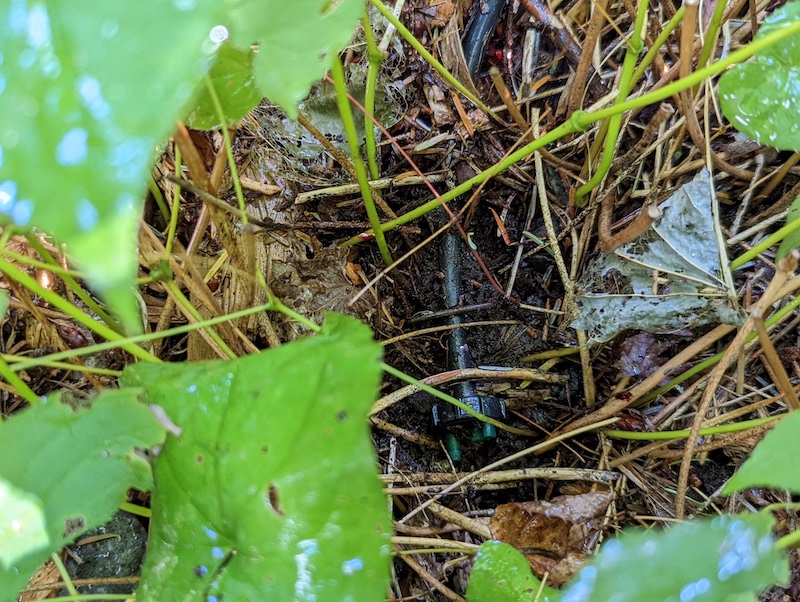Barrenwort, also called Bishop’s Hat, is a drought-tolerant flowering shade perennial. Regular watering in the first year or so after planting will help ensure the development of a strong root system. With these tips, you can help your barrenwort not only to survive, but to thrive, producing vibrant spring blooms and colorful, long-lasting foliage.

How To Tell If Barrenwort Needs Watered
Plants often have the ability to tell us when they need water if we take some time to look for the signs. Barrenwort, like many plants, will overtly droop when under-watered. Prolonged under-watering may lead to crispy, dry leaf edges, yellowing lower leaves, and short-lived flowers. If the soil is dry and cracked, you may need to up the frequency of your waterings in addition to increasing the amount of water you are providing.
Remember: infrequent deep waterings are more beneficial than frequent small sips of water, encouraging perennials to grow deep, strong roots instead of shallow roots.
Because the symptoms of overwatering often mimic those of under-watering, when you notice your plants wilting, it is important to feel the soil a few inches down to make sure that the soil is truly dry before watering. Oversaturated soil can lead to root rot and other plant health issues, which may result in plant death. Overwatering symptoms include wilting, brown leaf spots, leaf loss, soggy stems, and stinky soil.

How Often To Water Barrenwort
Many drought-tolerant perennials do not start off able to survive without regular watering, and barrenwort is no exception. In the plant’s first year or so in your garden, you will want to water regularly and deeply, encouraging it to grow deep, healthy roots to become established. The frequency of water will depend on how much direct sunlight your barrenwort gets, the weather (e.g. rainfall), and the type of soil in your garden.
To plant for success and make watering easier, plant barrenwort in well-draining acidic soil, using soil amendments when necessary. Then, keep the area moderately watered but not soggy, never allowing the soil to completely dry.
Once barrenwort is in its second year, watering can be tapered down. While barrenwort can handle drying out a bit, you will want to make sure you help it along in the hottest, driest parts of the year. Barrenwort is tolerant of dry shade, though regular watering will keep it happier and healthier.
When perennials are planted in shade, they have less access to direct sunlight and typically consume water at a slower rate than those in full sun. For this reason, the soil around your shade perennials may stay damp for longer, increasing the chance of overwatering. To prevent overwatering, be sure to plant barrenwort in well-draining soil and check that the soil is drying out slightly before watering again. Roots need access to air, and soggy soil prevents that.
Perennials in pots and planters tend to need a bit more attention when it comes to watering. Potted plants have less soil around them, which holds less moisture. Just as in the ground, you will want to frequently check how damp the soil is to avoid allowing the soil to dry out completely. Be sure to use well-draining potting soil, use a pot with drainage holes, and water barrenwort deeply when it needs it.
Best Time To Water Barrenwort
Watering plants in the early morning is best. By avoiding watering in the hottest part of the day, you will conserve water and help ensure that your plants are being watered more deeply. In the summer months, the frequency of watering will depend on how much sun your barrenwort gets, the type of soil it is planted in, and the weather.
In cooler, rainier regions, you may not have to water very frequently, especially if your plants are in a shady spot. In a hot, dry location, you will need to check your soil frequently to avoid underwatering. In northern, colder climates, many perennials go dormant and do not need to be watered in the winter months.
How to Water Barrenwort
Step 1 - Check soil moisture.
Feel the soil directly around the roots of the barrenwort by inserting your finger into the soil. Wet soil will feel cool, while dry soil will feel warm and gritty.
Step 2 - Water when soil is slightly dry.
Using a hose or watering can, water around the barrenwort. Though the majority of the roots are directly below the foliage, it is also a good idea to water the soil a few inches around your plant as well to encourage the roots to grow wider and deeper. The water should seep into the soil, and you will want to spend about 1 minute per plant. Remember that watering deeply is important in helping your perennials grow deep roots.
Step 3 - Allow soil to dry slightly before watering again.
In the first year, keep the soil around barrenwort moist but not soggy. Never allow the soil to dry completely. After barrenwort is established, it can tolerate dry shade, though it may still need regular watering.
Barrenwort Watering Tips
- Barrenwort is drought tolerant when established
- Do not allow soil to dry completely, especially in the first year
- Soil should remain moist but not soggy
- Plant barrenwort in well-draining, acidic soil for best results
- The frequency of watering will depend on how much sun and heat barrenwort gets
 |
Author Lynn Gusman - Published 1-12-2023 |
